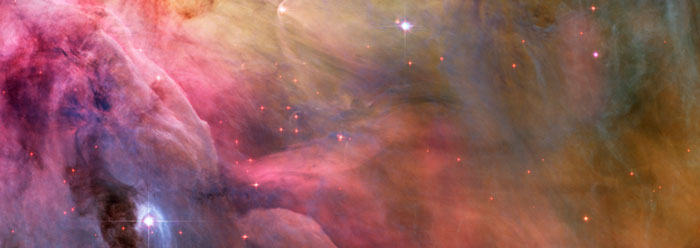Since the Big Bang story of the origin of the universe has been refuted by a host of external observations and internal contradictions,1 secular science has been forced to postulate additional, exceedingly improbable events to keep it afloat. One of these is “inflation,” which attempts to explain the apparent uniformity of the universe.2 But new observations by the Wilkinson Microwave Anisotropy Probe are forcing cosmologists to revamp inflation, at the cost of inventing yet another miraculous event to prop it up.3
Inflation holds that 10-36 seconds after the Big Bang was ignited, the expansion rate of the universe increased by a thousand billion billion billion-fold. It was supposedly an explosive event that followed immediately after the larger explosive event. This hypothesis, however, fails to address critical deficiencies in the overall Big Bang model.
Supposedly, inflation miraculously provided the force necessary to keep the newly-ignited material of the universe from immediately collapsing upon itself.4 Inflation also attempted to solve the horizon problem—how the universe could have achieved the incredibly uniform temperature that it has in only 13.8 billion years, when at least twice this length of time would have been necessary.5
The universe had to expand at a certain rate to prevent self-collapse, but this rate is many times the speed of light. Contrarily, the nascent universe must have expanded slower than the speed of light in order for that light to have had enough time to bathe every “corner,” for only in this way could the temperature be so consistent throughout today’s universe. But this means the universe must have expanded faster than it physically could have, rendering inflation flat. Two additional problems with inflation include “(a) how to get it started, and (b) how to stop it.”6
The newest measurements of the temperature of space (called the CMBR) add even more complications. Half of the universe has temperature and density variation patches, and the other half is quite smooth. According to the California Institute of Technology scientists who published their Wilkinson Microwave Anisotropy Probe observations, “Such an asymmetry cannot be generated during single-field slow-roll inflation without violating constraints to the homogeneity of the Universe.”3 In other words, the old inflation hypothesis cannot account for the lopsided universe, if indeed these new CMBR measurements are accurate.
Thus, Caltech astrophysicist Sean Carroll offered “a new version of inflation theory” in which one “field” was “responsible for ballooning the size of the universe, while a second field…introduces the density variations.”7 But this additional field comes with a cost. It “requires the introduction of a large-amplitude superhorizon perturbation to the curvaton field.”3 This perturbation structure, Carroll proposed, would have existed prior to inflation, but it only adds another ad hoc assumption to Big Bang’s big list. Where would the specifications of this newly proposed perturbation have originated?
Carroll’s effort to reconcile this recently discovered asymmetry of the universe, albeit into a woefully inadequate cosmology, is at least some kind of attempt to reckon with the new data. His team awaits more accurate measurements of the CMBR, which will come from a satellite called Planck that is set to launch in 2009.
Cosmologies other than, and better than, Big Bang are currently being investigated, and several of them predict the young world as described in the Bible. The information that can actually be measured from the universe soundly contradicts the Big Bang’s series of miraculous natural events,8 but it fits well with a biblically consistent view of the structure and origin of the universe.
References
- See “An Open Letter to the Scientific Community” on cosmologystatement.org, in which hundreds of scientist express their agreement with the statement “The big bang today relies on a growing number of hypothetical entities, things that we have never observed—inflation, dark matter and dark energy are the most prominent examples.”
- Guth, A. H. 1981. Inflationary universe: A possible solution to the horizon and flatness problems. Physical Review D. 23 (2): 347-356.
- Erickcek, A. L., M. Kamionkowski, and S. M. Carroll. 2008. A hemispherical power asymmetry from inflation. Physical Review D. 78 (12): 123520.
- Inflation was also used to help explain the absence of “magnetic monopoles” that should have formed when magnetic and electric forces united, but which have not been found in the universe. Inflation would hypothetically have stretched these forces out so thinly that they are not observable today. If this were the case, however, then there is no reason why standard elementary particles such as protons would not also be stretched too thin to detect.
- Thomas, B. We Now Know. ICR News. Posted on icr.org on June 27, 2008, accessed January 16, 2009.
- Hartnett, J. 2005. Dismantling the Big Bang. Green Forest, AR: Master Books, 125. See also Coppedge, D. F. 2007. Inflating the Evidence. Acts & Facts. 36 (12): 15.
- Moskowitz, C. Lopsided Universe Hints at Time Before Big Bang. Fox News. Posted on foxnews.com January 15, 2009, accessed January 16, 2009.
- This series includes: a) the singularity; b) energy is converted to matter, but not antimatter; c) the ignition of the Big Bang; d) the ignition of inflation; e) the deceleration of inflation; f) compaction of expanding gas into stars; g) ordering of stars into galaxies, many with rotation; h) ordering of galaxies into superclusters; and i) ordering of matter into planets, with unique orbits, rotation axes and rotation directions.
Image Credit: NASA
* Mr. Thomas is Science Writer.
Article posted on January 29, 2009.

















